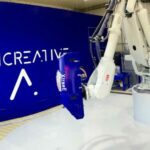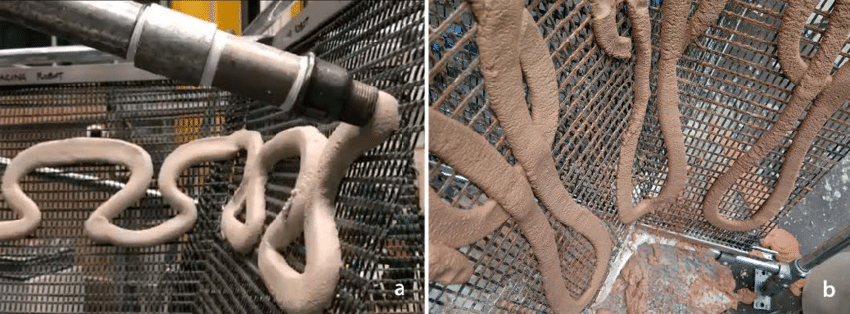Researchers have long been looking for lighter concrete printing tech, making transport and processing smoother. This is especially relevant for robot-based building processes due to the obvious issue of robotic motion and speed. However, a joint research project may have cracked the code on this with a new method. SCRIM (Sparse Concrete Reinforcement In Meshworks) combines robot-based concrete 3D printing and textile reinforcement meshes to produce lightweight structures using 6-axis automated control.
The joint project between the Royal Danish Academy of Fine Arts Schools of Architecture, Design and Conservation (KADK) and the Danish Technological Institute (DTI) has found a new approach to 3D printing in construction. The method employs the full exploitation of 6-axis robotic control by utilizing supportive meshes to create 3D surfaces where concrete concrete deposition can occur at various orientation angles. Think of it as depositing concrete over a chain link fence, which is what the process looks like at first glance.
Instead of fully encapsulating the textile in a cement matrix using formworks or spraying concrete, SCRIM relies on sparsely depositing concrete to achieve structural, tectonic and aesthetic design goals, minimising material use. The idea is to allow the arm a full range of motion, while the mesh supports the structure base. This hybrid form allows for far sturdier constructs.
The process is also very eco-friendly, allaying the typical concerns that often arise from concrete production. Concrete, being the most common material in construction, is low-cost and easily processable. It’s worldwide consumption has made a heavy contributor to CO2 production. As a result, the negative KADK researchers developed digital fabrication methods which were open new design possibilities and construction practices.
The SCRIM Process
While most forms of printing construction have focused towards on-site development, SCRIM takes a different route. “From a design perspective, this opens new creative potentials. [It] enables off-site printing and component-based assembly. In addition, because concrete is selectively deposited, this helps reduce concrete consumption and enable the production of lighter building components.” remarked Phil Ayres Teaching Associate Professor and Researcher at KADK.
As of now, the researchers are planning to improve the concrete mix design, boosting its relevant properties. Additionally, they are going develop a tailored carbon fiber reinforced polymer mesh for adaptive robotic control. The current process is still in the prototype stage, so further iterations will need tailor-made equipment.
The researchers are seeking industry partners so that the concept can undergo new production and construction field-tests. The technology is a novel approach to hybrid processes. It could definitely allow for more elaborate off-site construction, as well as on-site development. The process lends itself to new forms and we’ll see how companies make use of it in the future.
Images courtesy of KADT/DTI.





